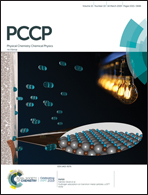Magneto-Seebeck effect in Co2FeAl/MgO/Co2FeAl: first-principles calculations
Abstract
The magneto-Seebeck effect has recently attracted considerable attention because of its novel fundamental physics and future potential application in spintronics. Herein, employing first-principles calculations and the spin-resolved Boltzmann transport theory, we have systematically investigated the electronic structures and spin-related transport properties of Co2FeAl/MgO/Co2FeAl multilayers with parallel (P) and anti-parallel (AP) magnetic alignment. Our results indicate that the sign of tunneling magneto-Seebeck (TMS) value with Co2/O termination is consistent with that of the measured experimental result although its value (−221%) at room temperature is smaller than the experimental one (−95%). The calculated spin-Seebeck coefficients of the Co2/O termination with P and AP states and the FeAl/O termination with the AP state are all larger than other typical Co2MnSi/MgO/Co2MnSi heterostructures. By analyzing the geometries, electronic structures, and magnetic behaviors of two different terminations (Co2/O and FeAl/O terminations), we find that the two terminations in the interface region form anti-bonding and bonding states, reconstructing the energy gap, changing the magnetic moment of O atoms, and improving the spin-polarization (−82%). This phenomenon can be ascribed to the charge transfer and hybridization between Co/Fe 3d and O 2p states, which also results in a bowknot orbital shape of Co atoms with Co2/O termination and an ankle shape of Co atoms with FeAl/O termination far away from the interface. Moreover, there are spin-splitting transmission gaps with the Co2/O-termination around the Fermi level, while the transmission gaps with the FeAl/O-termination are closed and thus show a typical metallic character. Our findings will guide the experimental design of magneto-Seebeck devices for future spintronic applications.



 Please wait while we load your content...
Please wait while we load your content...